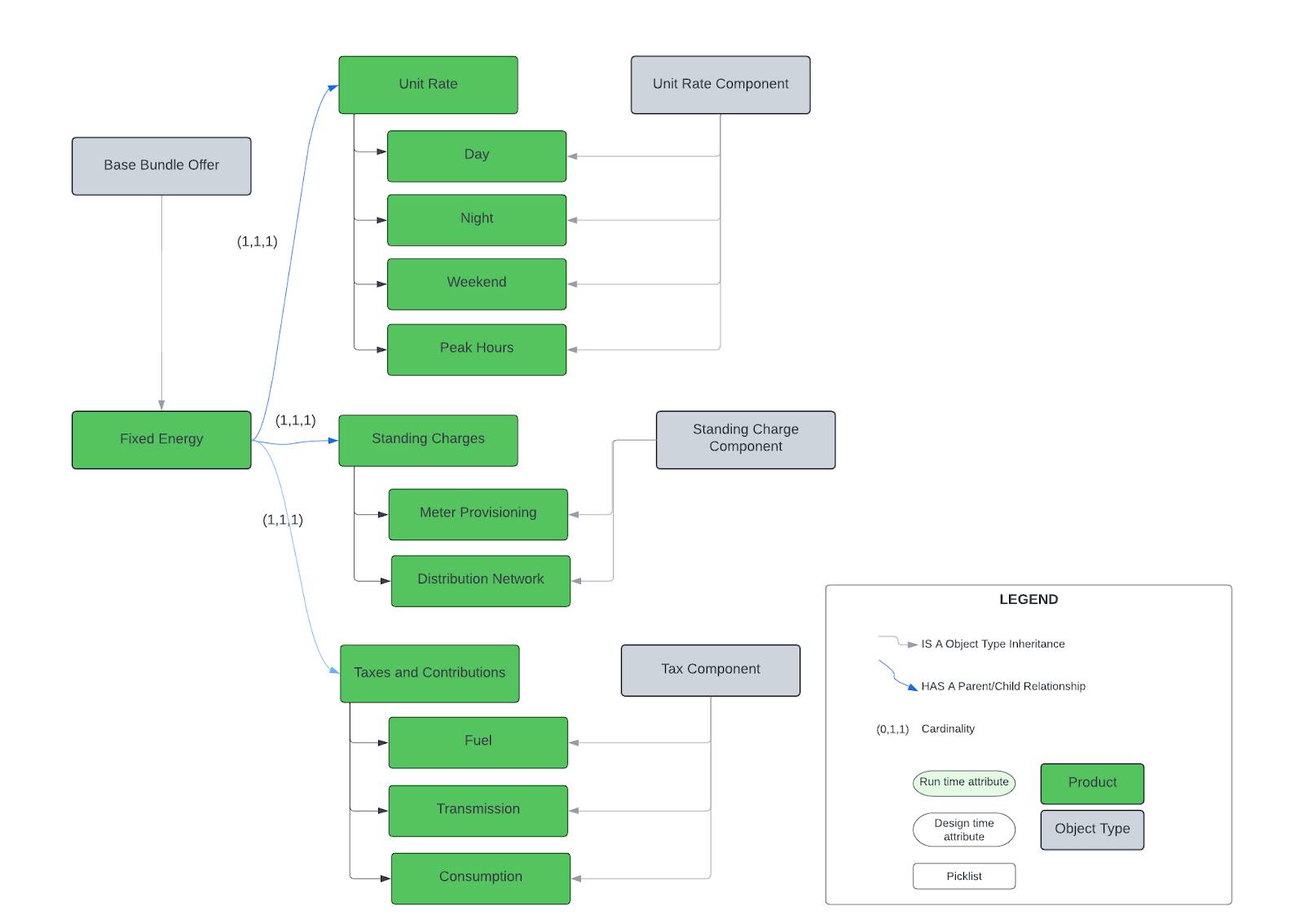業界固有の商品モデルを調べる
学習の目的
この単元を完了すると、次のことができるようになります。
- メディア、エネルギー・公益事業の商品モデリングが通信業界とどのように異なるかを説明する。
- Communications Cloud 固有のカタログコンポーネントの 4 つの Shared Information/Data (SID) 仕様種別を挙げる。
- 商品モデリングでのさまざまな対応付け手法を説明する。
業界の商品データモデル
いくつもの商品モデリングパターンとその組み合わせを使用できることで、Devi はプロセス全体にやや気後れしています。まだ金曜日じゃないんだろうか、と彼は思います。幸い、このカタログデータの計画を立てるのは彼が初めてではありません。
ここまでは、通信業界に注目してきました。次は、商品モデリングの観点からメディア、エネルギー・公益事業業界について学習します。各業界には商品販売に関する固有の課題や考慮事項があるため、長年の間に各業界の具体的なビジネス目標を達成するためのさまざまなデータフレームワークが開発され、その有効性が実証されてきました。まずは通信業界から始めて、そこから進んでいきましょう。
通信業界の商品モデル
Telemanagement Forum (TM Forum) は通信サービスプロバイダー (CSP) とそのサプライヤーの最大の協会です。長年にわたり、メンバーとのコラボレーションを通じて TM Forum は業界標準やガイドラインを確立してきました。その中には、データ管理や情報フレームワークのためのベストプラクティスも含まれています。
その 1 つのフレームワークが Shared Information/Data (SID) モデルで、Open Digital Framework とも呼ばれています。これは、Infiwave のような通信企業を経由するすべての情報の標準定義を提供するものです。Salesforce Industries Communications Cloud は SID に準拠しており、このデータモデルを使用するためのツールを備えています。
SID モデルを使用してコンポーネントを次の 3 つのレイヤーに整理することで、カタログと注文管理を簡略にして合理化できます。
- 商品仕様レイヤーは企業が販売するものの商業用ビューです。すべてのコマーシャルプロダクトとその特性、価格設定、プロモーション、割引が含まれます。
- 顧客向けサービス仕様 (CFSS) レイヤーにはコマーシャルプロダクトの分解と履行をサポートする技術的な商品とサービスが含まれます。
- リソース向けサービス仕様 (RFSS) レイヤーには CFSS レイヤーをサポートするリソースが含まれます。
次の図では、テレビとインターネットの商品バンドルにインターネットと音声の商品仕様が含まれています。
これらの商品仕様はお客様がバンドルを注文したときにインターネットと音声のサービスに分解されます。分解とは小さな部分に分けることです。それによって下流のリソース (スケジューリング、配送、インターネットと音声のリソースなど) に変換され、注文管理システムで注文を履行するために使用されます。
この 3 つのレイヤーには、通信商品に固有のカタログコンポーネントの 4 つの主な SID 定義が含まれています。商品モデルを開発するときには、これらのコンポーネントを使用してカタログエンティティの特定と分類を行うことができます。
各 SID 使用種別を見てみましょう。
TM Forum SID 商品モデリングプロセス
Devi が TM Forum SID 商品モデリングプロセスを使用して商品カタログの作成を開始する手順を見ていきましょう。
- ステークホルダーと一緒に検出を実行して要件を収集します。
- 商品モデリングの凡例を定義します。

3.オファーとそれに関連する仕様の 1 対 1 のリレーションを示すように対応付けます。
電話オファーとそれに関連付けられた商品仕様は次のようになります。

4.電話のモデルを関連属性に対応付けます。
Devi はブランド、容量、モバイル OS などの電話固有の属性とそれに関連付けられた選択リストをオブジェクト種別に追加します。開発中に商品仕様はこの属性を継承し、Devi はそれに商品固有の値に割り当てます。

5.分解リレーションを追跡できるように、バックエンドのテクニカルプロダクトを商品仕様に対応付けます。
Devi はテクニカルプロダクトである SIM カードを商品仕様に追加します。このような技術的側面はお客様には無関係であるためカートには表示されません。

6.各コマーシャルプロダクト仕様とオファーについてこのプロセスを繰り返し、オファーをバンドルにまとめます。
ご覧のとおり、モデルは大きくなっています。

Devi は子商品をバンドル商品にグループ化し、カーディナリティを割り当てます。この図のバンドル例には電話とスマートウォッチの子商品と、その最小数量、デフォルト数量、最大数量が含まれています。
電気通信業界では CSP は従来の IT システムをサポートするためにこのような階層モデリングパターンをよく使用します。この方法では、静的で設定可能なバンドル、キット、機能の選択肢を作成できます。
7.すべてのバンドル、商品、リソース、サービス、属性、選択リストが対応付けられたら、オブジェクト種別とサブ種別のセットを作成して、特定の商品ラインを作成する際の効率を最大化します。
ここでは Devi はデバイス、ハンドセット、スマートウォッチのオブジェクト種別を含むオブジェクト種別階層を追加しています。

次に彼は各コマーシャルプロダクトと技術商品がそれぞれのオブジェクト種別から継承する属性をグループ化します。
Devi は完成した商品モデル図を眺めてみます。よく練られた商品モデルによって、長期的に多くの時間を節約できそうです。少し時間をかけてエンティティ、属性、オブジェクト種別を対応付けたことで、今後の商品設計とメンテナンスが簡単になりました。商品モデルが完成し、Devi は明確な計画を持って共有カタログのオファーとコンポーネントを作成できます。
メディア業界の商品モデル
次に、メディア業界の商品デザイナーが会社の商品をどのように設定するかを見てみましょう。「メディア業界」 Trailhead モジュールを修了している方は、商品とサービスが次のカテゴリに分類されることをご存じだと思います。
- デバイス、サービス、インフラストラクチャ (アクセスプラットフォーム、視覚技術、ストリーミングデバイスなど)
- テレビコンテンツパッケージとサードパーティアプリケーション
- 季節チケットと無料視聴
- 1 回限りのイベントまたはビデオオンデマンド (VOD)
- 追加料金
各商品カテゴリで 1 つ以上のモデリングパターンを採用することが考えられます。例を見てみましょう。
通常、メディア放送会社は、マーケットセグメントに基づいて、チャンネルのセットを主なエンターテイメントパッケージにバンドルします。共有カタログでこのようなチャンネルを設定するときには、アーキテクトは個々のチャンネルがスタンドアロン商品となるフラットパターン手法を使用できます。チャンネルがカートに追加されると、自動追加ルールを使用して、その他のパッケージ化されたチャンネルも自動的に追加されます。
別の選択肢として、階層パターンを使用することも考えられます。その場合、次の図のように親商品はバンドルのコンテナとなります。

モデル内で、モバイルストリーミングバンドルの親商品には子サブスクリプション商品が含まれます。この商品はサブスクリプションオブジェクト種別からメタデータを継承しています。
視点を変えて、同じように活気のあるエネルギー・公共事業業界を見てみましょう。
エネルギー・公共事業業界の商品モデル
「エネルギー・公益事業業界」Trailhead モジュールを修了した方は、エネルギー・公益事業企業がお客様の電気、ガス、その他の商品の使用量を追跡するために単価を使用していることを覚えておられると思います。お客様がエネルギー使用を抑えることを奨励するために、単価を時間帯に基づいて変動させることもあります。
この変更に対応するために、商品デザイナーは単価の親商品バンドルを作成し、時間帯ごとの使用料金設定を保存する子商品を含めることができます。また、供給ネットワークなどのインフラストラクチャのコストを賄うための定額の基本料金の商品を設計したり、透明性を高めるためにオファーの一部として税金を含めたりすることもできます。
次の図では、Fixed Energy (固定レートエネルギー) 商品に、価格を定義するための単価、基本料金、税金および負担金の 3 つのバンドルがあります。

単価商品にはさまざまな時間帯の料金が保存され、基本料金には供給とネットワークの料金が含まれ、税金および負担金商品バンドルでは、税金と、燃料、送出、消費に基づく料金が追跡されます。
モデルを作成しましょう
ここでは、通信、メディア、エネルギー・公益事業業界での TM Forum SID 商品モデリングプロセスのしくみを学習しました。これで皆さんは、共有カタログを最大限に活用するために各自の視覚的階層を作成する準備ができました。
次は、商品の有効期限が商品モデリングにどのように重要な影響を及ぼすかを学習します。さらに、Industries 共有カタログ機能を使用して反復的な変更を管理し、商品のライフサイクルを計画する方法についても学習します。
